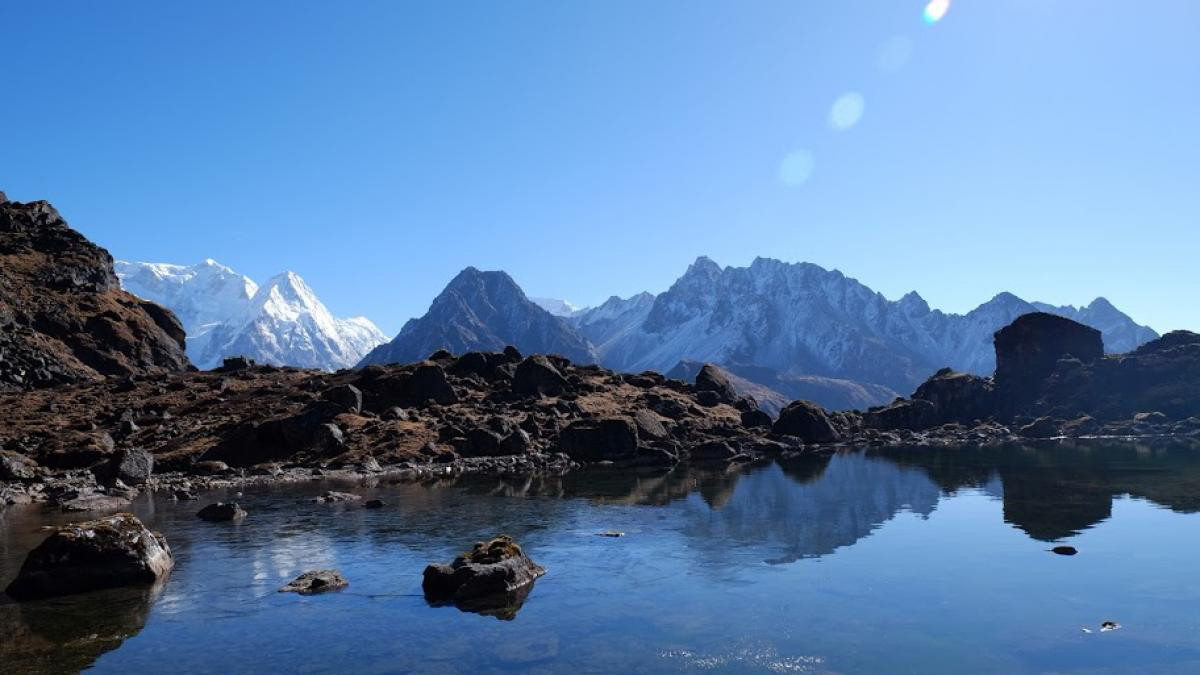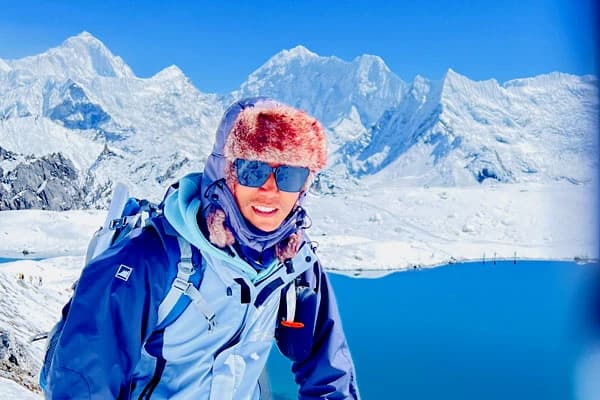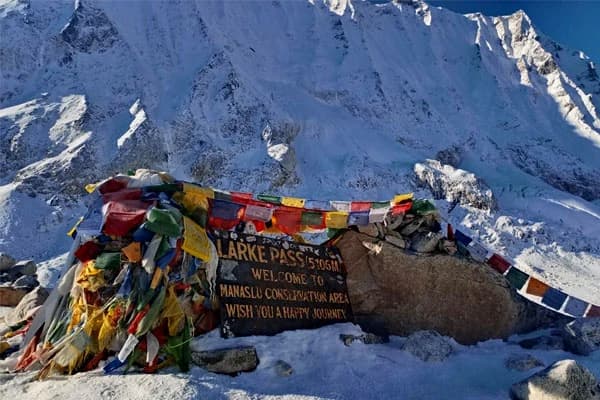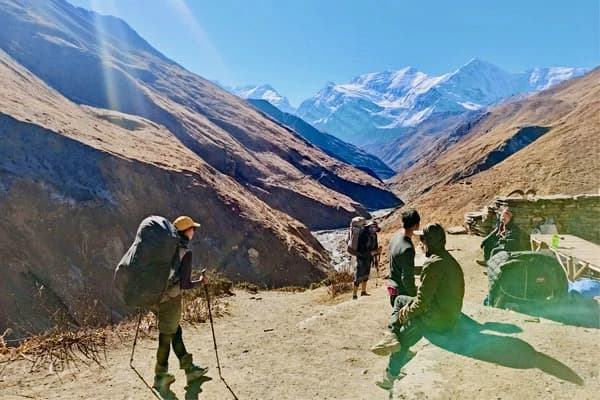Exploring the Kanchenjunga Region: A Brief Overview
Located in the eastern region of Nepal, which shares its border with Taplejung and Sikkim-India, is marked on a map as a home to the world's third-highest peak - Mt. Kanchenjunga, where the name is inspired by. The Kanchenjunga region is widely featured with diverse landscapes, varied kinds of terrains, from woodlands thrived with wild flowers, settlements of locals, and surrounded by the massive towering mountains, being Tibetan influenced with several monasteries and glacial lakes, rugged or remote terrains, and alpine valleys over 4000 meters.
Being protected by the "Kanchenjunga Conservation Area", it is one of the remotest and least crowded trekking trails in Nepal, where certain restrictions are implemented by the government of Nepal to protect the untamed biodiversity of Himalayan flora and fauna, and the rich cultures of the indigenous communities, residing here for ages.
Spanning across 2035 sq. kilometers, various ethnic groups such as Limbu, Rai, Tamang, Lepcha, Bhutia communities, call this mountain area home, and have been preserving their rich cultures and traditions, being highly influenced by the Tibetan traditions, from generation to generation, where the ancient hamlets, lifestyles, and their festival celebrations, are the real proof for sure.
Today, in the present day, the Kanchenjunga region acts as a popular trekking route for explorers who seek to explore the unblemished culture, traditions, and insight into the remote lifestyle of the locals. While wandering around this territory, you will be accompanied by the Five Kanchenjunga massifs, via a distinct overview, and the thundering landscapes, with a possibility of encountering some rare wild species such as the Himalayan black bear, snow leopard, elusive red panda, musk deer, or spotted deer, hiding beside the blooming red rhododendrons, and wild flowers.
With the untamed beauty, unchanged culture, and the remote trailhead, with serene and pristine surroundings, today, the Kanchenjunga area stands out being one of the UNESCO World Heritage Sites, and the best off-beaten remote treks and a part of the Great Himalayan Trail, at the same time.
What Makes Kanchenjunga Nepal's Premier Trekking Destination?
Here are some of the top 10 attractions of the Kanchenjunga, which make it one of the best trekking destinations in Nepal:
- Showcases the panoramic vista of the Kanchenjunga massif alongside Jannu, Rathong, Kabru, and Makalu, and the Everest peaks through favorable weather from their observation spot. During their progression, the trekkers will experience two high passes at Sele La (4290 m.) and Sinion La (4500 m.), which will reveal various eight-thousand-tall mountains.
- Walk through the protected area where numerous wildlife species, alongside a wide range of ecosystems which house 2,000 plant species as well as 200 wildlife species, including snow leopards and red pandas, and Himalayan Black bears, and Danphe.
- Meander along the blooming, thriving red rhododendrons, pines, along other wild flowers, where the path slowly reveals majestic mountain passes that showcase rivers, glacial lakes, waterfalls, and alpine meadows, creating a peaceful environment.
- Visit the less-visited trekking trail and one of the off-beaten trailheads, where the ancient tea houses are just in their pristine conditions, offering an authentic tea house experience in the world of modernization.
- Explore the distinct insight of the world's tallest peak - the Kanchenjunga Range, and visit the two base camps, the North base camp and South base camp, at the same time.
- Be a part of the Great Himalayan Trail, covering some iconic spots while venturing out on this odyssey
- Relish in the warm hospitality of the diverse indigenous communities of Rai, Lepcha, Sherpa, Limbu, and many others, being highly influenced by the Tibetans, and try their authentic cuisines, made out of love, and get a warm hospitality with a reward of happy smiley faces of the locals.
- Traverse through the glacial, deep valleys, roaring rivers, lush forests, and come across several suspension bridges and thundering rivers such as the Arun River and Ghunsa Khola.
- Get amused by the mythological stories circulating, such as the mystery of the Snow Man, also known as YETI, which can only be found in the Himalayas - a belief of the locals.
- Pass through the Tibetan dotted route, visiting several ancient monasteries, listening to the prayers and chantings of the monks, and be a part of the lively festival celebrations and pujas (prayers), held by the locals.
Kanchenjunga Trekking Routes: North Base Camp, South Base Camp & Circuit
The Kanchenjunga region has several trekking routes that you can venture out on, exploring the unique features. While many consider the Kanchenjunga Base Camp solely be the ultimate destination, actually, the route is distinguished into two base camps, which stand out to be the Kanchenjunga North and South Base Camps. Both the lap of the almighty peak has distinct viewpoints and distinct features, with a unique overview of the Himalayan beauty.
However, the North is the main base camp of Mount Kanchenjunga, which reaches the highest elevation of 5143 meters at Pang Pema viewpoint. These two base camps navigate through the same trekking route, and if someone wants to have ample time duration, then the Kanchenjunga Circuit Trek is the perfect choice for you, which attains the north and south base camps at once, exploring the deep remote trailhead, and encompassing the world's 3rd tallest peak of Mount Kanchenjunga.
Kanchenjunga North Base Camp Trek
The base camp of the North Kanchenjunga soars at an elevation of 5143 m (16,873.36 ft), which is also named Pangpema, unveiling the heavenly beauty of the rich Himalayan flora, fauna, and panoramic view of the Kanchenjunga main and other surrounding peaks. The Kanchenjunga North Base Camp Trek is a bit challenging, which takes approximately 14 to 16 days, starting from the capital city - Kathmandu, passing through the rugged, remote, isolated trailhead, demanding 6 to 7 hours of walking pace per day, with a total distance coverage of 194 kilometers.
This trip is a thrilling adventure, and strenuous compared to the southern trekking route, because it involves a cross over two highest passes over 4000 meters, firstly, the Sele La Pass (4290 meters), and secondly, the Sinion La Pass at 4660 meters, with an incredible view of several giants such as Khumbhakarna, Ramtang, and the Kanchenjunga range itself. Meanwhile, the other eight thousanders, such as Makalu, Everest, and Lhotse, promise to awe you at their best form.
From the navigation starting from the woodland, of the thriving forest of the blooming wild flowers, with the rugged, brown, towering landscapes, with the high mountains, alpine valleys, and glacial lakes of Nupchu, offering a 360-degree view of Mount Jannu, which is visited during an acclimatization day at Khambachen. Hence, this trip is a perfect complete package of thrill, challenges, and cultural exploration, rewarding you with a sense of accomplishment after attaining a new height.
Kanchenjunga South Base Camp Trek
The south base camp of Kanchenjunga is perched at an altitude of 4840 meters, at the Oktang viewpoint at 4840 meters, offering the closest view of the southern face of the Kanchenjunga massif, with a rich cultural exploration of the Rai and Limbu communities.
Compared to the north base camp, the Kanchenjunga South Base Camp Trek is easier and smoother to undertake, demanding a shorter trip duration of 10 to 12 days, which showcases six climatic zones of the remote trailhead. Starting the journey with a dense forested area of thriving wild flowers, with an exploration of the ancient villages and terraced fields, of the locals, and ascends to the alpine woodlands, dotted with breathtaking glaciers, and the panoramic insight of the Mount Makalu, and Jannu Himal via the possible insight of the Himalayan wildlife of Black bear, snow leopard, and others.
During this journey, several iconic peaks such as Mount Kabru, Ramtang Peak, Mount Rohtang, Nepali Chuli, Kirat Chuli, with the vista of the Yalung Glacier, reward you with their unhindered panoramic insight. During an acclimatization day, before ascending to the south base camp, it takes you to a deeper exploration of the local lifestyles and cultures at Tseram (Cheram) village.
Kanchenjunga Circuit Trek: Visit both north and south base camps
The Kanchenjunga Circuit Trek combines both the trips into one single adventure, which encircles the world's 3rd highest peak, and attains both viewpoints of Pang Pema at 5143 meters and Oktang View Point (4840 m), via the remote rugged trailhead. Combining both the iconic Himalayan adventure makes the overall trip challenging, which crosses over several high mountain passes, with an insight into the surrounding landscapes and the snow-capped peaks. This trek takes almost 19 days to complete that beginning with a flight to Taplejung, which is marked as a gateway to the Kanchenjunga region, covering the first trailhead of the Kanchenjunga North Base Camp, and attaining the South Base Camp, exploring the restricted, isolated area.
Kanchenjunga Trek Solo Vs Guided Journey
Are you a solo trek kinda person? If yes, then the journey to Kanchenjunga might have a little issue. The Nepalese government has established certain rules for individuals going solo on treks in the Kanchenjunga region. The law restricts unguided solo hiking on trails and requires at least two trekkers with a licensed porter or guide. The authorities implemented this restriction mainly because of safety needs in the remote Kanchenjunga region, where weather unpredictability meets challenging mountains and poor medical services availability.

The necessity of a guide will improve the Kanchenjunga trekking experience by sharing knowledge about local life as well as helping people stay on track. In a group, you will have travel companions who can share interesting travel stories so you don't feel bored. You can get help in emergencies, and our guide will take care of your logistics. Yep, it's that easy!
You might feel overwhelmed by this news as a solo trekker. Do not panic, we've got your back! Our program welcomes solo travelers who can book their departure slots for 2025 and 2026 dates, as numerous solo travelers have already joined.
How to reach the Kanchenjunga Base Camp?
International flight to Kathmandu
The journey to the Kanchenjunga region starts when you book an international flight to Nepal's capital, where Tribhuwan International Airport serves as your entry point to your epic adventure. As soon as you arrive, our team will lead you from the airport to your hotel accommodation. Anyone embarking on a Nepalese adventure must obtain the required travel documents, which facilitate visa processes upon arrival.
Flight from Kathmandu to Bhadrapur
The next step requires you to board a domestic flight that will transport you to Bharatpur. The scheduled flight will cover a 40-45 minute journey, which moves toward eastern Nepal to the Jhapa district for your landing.
Traveling to Bhadrapur by air represents the optimal solution when starting your journey at the initial location. Travelers can reach the Taplejung district by driving from Bhadrapur airport, which requires at least 8-9 hours of travel time. By choosing this method, you get to experience a comfortable beginning to your adventure.
Taplejung can be accessed through additional transportation options. Suketar Airport at Taplejung remains unreliable because weather conditions frequently disrupt flights and lead to delays. The drive linking Kathmandu to Taplejung is lengthy and requires many hours to reach your destination. You may experience discomfort from the rough conditions on the roads. Thus, the optimum travel choice is to fly to Bhadrapur.
Drive to Kanchenjunga Region (Taplejung)
Travelers undertake an approximately 8 to 9-hour drive from Bharatpur toward Taplejung, which is the access point to the Kanchenjunga. Your journey includes traveling through rich forested areas and past rivers while passing small towns and towns with traditional houses and viewing various scenery throughout the hilly mountains. From this entry point, you need to select your desired trekking route. We have 5 options available for you according to your preference, time, and fitness level.

No matter the route you choose, the Kanchenjunga Circuit Trek will be one for your books!
Kanchenjunga Trekking Itineraries
So you want an adventure in the Kanchenjunga region? There are 5 route options for you to do so. Each has its unique perspective and experience. Let's dig in further.
Kanchenjunga North and South Base Camp Itinerary (Kanchenjunga Circuit or Base Camp): Combined Journey
This 19-day Kanchenjunga Circuit Trek is a complete way of having the opportunity to visit both North and South Base Camps. Since you circulate the whole of Kanchenjunga mountain, you can explore the Kanchenjunga Region as a whole. Travelers cross two mountain passes above 4000 meters in elevation, named Sele La Pass and Mirgin La Pass, which form part of the route. Travelers need 19-24 days to finish this trek, which stands as a moderately difficult expedition. However, it is a perfect way to explore all sides of the region.

Best Kanchenjunga Circuit Trek Itinerary for 2025/2026/2027
Day 1: Arrival Day in Kathmandu and Transfer to the hotel by private vehicle
Day 2: Permit Preparation Day and Guided Sightseeing Tour
Day 3: Domestic Flight to Bhadrapur then drive by local jeep to Taplejung
Day 4: Taplejung to Sekathum
Day 5: Sekathum to Amjilosa
Day 6: Amjilosa to Gyabla
Day 7: Gyabla to Ghunsa
Day 8: Ghunsa to Khambachen
Day 9: Khambachen to Lhonak
Day 10: Khambachen to Lhonak
Day 11: Excursion to Kanchenjunga North Base Camp ( Pang Pema) and hike back to Lhonak
Day 12: Lhonak to Ghunsa
Day 13: Trek to Sela La Base Camp
Day 14: Trek from Sele La Base Camp to Tseram
Day 15: Tseram to Ramche and hike to Oktang( Yalung South Base Camp View Point)
Day 16: Tseram to Tortong
Day 17: Tortong to Yamphuding
Day 18: Drive from Yamphuding to Kanyam
Day 19: Drive from Kanyam to Bhadrapur and flight to Kathmandu

Alternative Route to Kanchenjunga Base Camp Itinerary
Day 1:Flught to Bhadrapur and Jeep Drive to Kanyam
Day 2: Jeep Drive from Kanyam to Taplejung
Day 3: Jeep Drive from Taplejung to Sekathum
Day 4: Trek from Sekathum to Amjilosa
Day 5: Trek from Amjilosa to Gyabla
Day 6: Trek from Gyabla to Ghunsa
Day 7: Acclimatization Day at Ghunsa
Day 8: Trek from Ghunsa to Khambachen
Day 9: Trek from Khambachen to Lhonak
Day 10:Trek from Kanchenjunga North Base Camp-Pang Pema and descend back to Lhonak
Day 11: Trek from Lhonak to Ghunsa
Day 12: Trek from Ghunsa to Sele La Base Camp
Day 13: Trek from Sele La Base Camp to Tseram
Day 14:Trek from Tseram to Ramche and Hike to Oktang (Yalung South Base Camp View Point), trek back to Tseram
Day 15:Trek from Tseram to Khebang
Day 16: Trek from Khebang to Hampu Khola, Drive to Taplejung
Day 17: Drive from Taplejung to Birtamode
Day 18: Drive to Bhadrapur, and fly back to Kathmandu
Kanchenjunga North Base Camp Trek Itinerary
The Kanchenjunga North Base Camp Trektakes you through the Kanchenjunga region, focusing on the northern part. The route leads you to the North Base Camp of Kanchenjunga. The expedition lasts for 14-16 days of moderate-level trek. It simply leads you to the Kanchenjunga northern base camp i.e., Pang Pema, but doesn't let you touch the south base camp. However, you'll cover 99% of the whole trip, it's just that you do not reach Oktang View Point. This trip is perfect for those who want to reach the base camp of Mt. Kanchenjunga but have a limited timeframe.
Day 1: Flight from Kathmandu to Bhadrapur and Drive to Ilam
Day 2: Drive from Ilam to Taplejung
Day 3: Drive to Sekathum
Day 4: Trek to Amjilosa
Day 5: Trek to Gyabla
Day 6: Trek to Ghunsa
Day 7: Acclimatization Day
Day 8: Trek from Ghunsa to Kambachen
Day 9: Acclimatization Day in Kambachen
Day 10: Trek from Kambachen to Lhonak
Day 11: Day Trip to Kanchenjunga North Base Camp
Day 12: Trek from Lhonak to Ghunsa
Day 13: Trek to Amjilosa
Day 14: Trek to Sekathum
Day 15: Drive from Sekathum to Taplejung to Bhadrapur
Day 16: Flight to Kathmandu
Kanchenjunga South Base Camp Trek Itinerary
Day 1: Flight from Bhadrapur to Kathmandu and Drive to Ilam
Day 2: Drive from Ilam to Taplejung
Day 3: Trek from Taplejung to Lali Kharka
Day 4: Trek from Lali Kharka to Khesewa
Day 5: Trek from Khesewa to Pumphe Danda
Day 6: Trek from Pumphe Danda to Yamphuding
Day 7: Trek from Yamphuding to Torongding
Day 8: Trek from Torongding to Cheram
Day 9: Trek from Cheram to Ramche
Day 10: Trek from Ramche to Torongding
Day 11: Trek from Torongding to Yamphuding
Day 12: Trek from Yamphuding to Ranipul and drive back to Phidim
Day 13: Drive back to Bhadrapur
Day 14: Flight to Kathmandu
Lumba Sumba Pass Trek Itinerary
Lumba Sumba Pass Trek presents an expeditionary journey into the Kanchenjunga Region through an exclusive trail that receives limited exploration. The route reaches Lumba Sumba Pass elevation (5,160m), which acts as a bridge combining the Kanchenjunga with the Makalu areas. The trek duration extends from 19 to 22 complete days. This expedition can be a little difficult because it consists of difficult technical areas. The Lumba Sumba pass trek itinerary:
Day 1: Flight from Kathmandu to Bhadrapur
Day 2: Drive from Bhadrapur to Taplejung
Day 3: Trek from Taplejung to Chirwa
Day 4: Trek from Chirwa to Lelep
Day 5: Trek from Lelep to Illa Danda
Day 6: Trek Illa Danda to Selep Kharka
Day 7: Trek Selep Kharka to Olangchung Gola
Day 8: Acclimatization Day at Olangchung Gola
Day 9: Trek from Olangchung Gola to Upper Langmale
Day 10: Trek from Upper Langmale to Lumba Sumba Pass Camp
Day 11: Trek from Lumba Sumba Pass Camp to Chauri Kharka
Day 12: Trek from Chauri Kharka to Thudam
Day 13: Trek from Thudam to Kharka
Day 14: Trek from Kharka to Chyamtang
Day 15: Trek from Chyamtanf to Hatiya
Day 16: Trek from Hatiya to Gola
Day 17: Trek from Gola to Hedangna Gadi
Day 18: Drive from Hedangna Gadi to Num to Tumlingtar
Day 19: Flight back to Kathmandu
Kanchenjunga Trek Permits
Since permits are checked at checkpoints, you must carry them for the journey. As per the government rules, permits can only be possible if you are trekking through a registered trekking agency like Destination Himalaya Treks and Expedition must trek along with at least one other person, and that doesn’t include the guide and porter. There are only two permits required for the trip to the Kanchenjunga region, mentioned below:
- Kanchenjunga Restricted Area Permit: USD 20$, NPR 2000/- per person
- Kanchenjunga Conservation Area Permit: USD 30$, NPR 3000/- per person
How difficult is it to trek to Kanchenjunga Base Camp?
Spoiler alert! Doing the Kanchenjunga Trekking is not a walk in the park, but it is not something you cannot conquer. Let me explain further. The journey is long. Like, long. The duration varies between 14 to 24 days based on the selected route. People need to dedicate weeks to exploring the remote, harsh landscapes across Nepal. The Kanchenjunga region is remote. Rugged trails consist of steep slopes along rocky paths. It requires 18-20 days to perform this moderate to difficult-level trek.
If you are planning to do the Kanchenjunga Base Camp Trek becomes even more strenuous. The trek requires 5 to 7 hours of average walking daily, yet several days reach 8 to 9 hours during high pass crossings and village-to-village travels. Walking during the trek demands both uphill climbs and downhill descents, and exploring uneven surfaces. All the views and feelings of victory make up for the effort you put into your journey. Also, mountain passes present serious challenges because they feature extreme steepness along with their icy surface.

The beginning of this trek represents a journey in itself. Trekkers must begin by taking a flight from Kathmandu to Bhadrapur, followed by a 7 to 8-hour journey by road to Taplejung. Every trek to high altitudes encounters the unwanted complication of altitude sickness, and Kanchenjunga is no different. You need to cover high altitudes and reduced oxygen levels at this elevation level lead to AMS symptoms, so you need proper acclimatization. While this trek may be a tough one, our Kanchenjunga Trekking itineraries are well-planned to make your journey easy and smooth.
Know more about the challenges of the Kanchenjunga Base Camp Trek in our detailed updated blog, with the preparation tips.
How to be physically prepared for this trek?
Kanchenjunga Trek is a long journey, so you need to be prepared for any possibilities and even unpredictable situations. First, you need to maintain a fit body. Your body needs to be fit to walk in rugged and uneven terrain, which makes your body work extra hard. So it's advised to start physical training before 3-4 months before. It is best to focus on cardio exercises, including hiking, running, and swimming.
Strength training will help build up your endurance. Focus on your core, back, and leg strength as these will take the most load in the journey. Make a habit of walking daily with at least a 5 kg loaded backpack. So lace up and hit that exercise!
And most importantly, keep a positive mindset. If you have strong willpower, it will drive you to move forward even if your body is tired. Your attention should remain fixed on reaching your end goal instead of fixating on obstacles. Meditation, along with yoga practice, is an effective method to maintain mental clarity.
What kind of meals and accommodations can to expect on the trail?
Kanchenjunga is a remote region, and you may worry about the accommodation options. The accommodation facilities offered by Kanchenjunga Trek are basic, and they get progressively more basic at higher elevations. The teahouses found in lower mountain villages have basic arrangements, including single rooms along with thin bedding and shared wood fire heating in dining areas. Tea houses provide basic amenities but require additional costs to access facilities such as WiFi, laundry, and hot showers.
When moving to the higher areas of Kanchenjunga, each room consists of two beds with shared washrooms. Villages at mid-elevations make basic services accessible, but solar power is available only occasionally. Each sleeping space in the high-elevation areas includes shared washroom facilities. Trekkers who need dependable accommodation opt for fully-supplied camping treks; however, this service needs porters and equipment.
Along the Kanchenjunga Trekking route, there is the option of traditional Nepali meals as well as international dishes. Breakfast includes Tibetan bread, eggs, pancakes, and porridge, but lunch and dinner traditionally serve Dal Bhat (power food), momos, soups, noodles, pasta, and fried rice. Fast energy replenishment can be achieved through eating energy bars and chocolate combined with nuts. Many hot drink options, like tea and coffee, are available.
The limited Food menu consists of fresh and filling meals that use locally harvested ingredients. The selection of vegetarian food options is extensive throughout the region, and eating meat should be avoided at high altitudes.
Preparations for the Kanchenjunga Trek: Things to consider before the journey
- Start your training at least four months before the trek while focusing on cardiovascular exercises (including hiking, running, and swimming), strength exercises that target your legs and core muscles, as well as endurance-building routines.
- You should apply the "climb high and sleep low" rule by hiking up in elevation throughout the daytime until descending during nighttime, mainly on your scheduled rest days, to adjust.
- Select a trusted trekking agency to make your journey smooth with a professional guide to navigate the remote trails of the Kanchenjunga Region. This will prevent you from getting lost or suck into difficult situations.
- Make sure to stay hydrated. It is a must for all trekkers to drink 3-4 liters of water throughout the day so they do not develop symptoms of altitude sickness. Just make sure the water is safe to drink!
- Do not try to push your body beyond its limit. Make sure that you take it slow at your own pace. Overworking your body can lead to severe problems later on the trek.
- Pack light with only the most essential things for the trek. Even if you hire a porter, carry a small bag containing medicine, water bottles, sunscreen, and lip balms.
- Layer up for any weather conditions. Pack all the necessary clothes.
- Be alert! You should look for the signs of altitude sickness, like headaches, dizziness, and nausea. If things get serious, descend or initiate an emergency evacuation that is covered by your travel insurance.
Kanchenjunga Trekking Cost
The Kanchenjunga Trek costs highly, depending on many number of trekkers in your group actually holds, the trip's overall duration, the transportation accessibility you are opting for, and mainly on the operator that you actually choose, and the additional services that you add to the package.
Meanwhile, our trek to Kanchenjunga costs start from USD 1500 and go up to USD 2499, per head, which depends on the number of hikers in the group; however, our package tends to cover all the essentials, such as trekking permits, transportation (flight and road) fare, lodges, standard meals, experienced licensed guide, porter and supporting crews, with additional gears and equipments as a complimentary. The cost and the route can be altered (managed), as per your pace, choice, and budget as well.
Personal Expenses
The Kanchenjunga Trek requires expenses for Wi-Fi usage at USD 3-5, laundry services for USD 2-5 per load, device charging for USD 2-3 each, and hot showers cost between USD 3-8. Also, consider tipping guides for USD 10-15 daily and porters for USD 8-10 daily, and budget USD 1-5 for snacks and drinks, especially when trekking at high altitudes. Power banks and packed wipes should serve as backups during the Kanchenjunga Trek route since hot showers along with Wi-Fi services, are challenging to find. The trek has no access to ATMs, so bring sufficient Nepalese rupees in cash during your journey. Travelers should expect to spend between USD 10 and USD 25 each day on personal expenses, according to their budget.
Conclusion: Final Say
The Kanchenjunga trek offers itself as an open invitation to those interested in Himalayan mountaintop experiences, natural scenes, and cultural sites. Your 2025 and 2026 bucket lists should include this transformative journey through natural landscapes, wildlife, and cultural experiences.
Are you ready for Himalayan mountaintop experiences, natural scenes, and cultural encounters? Walking on the trail allows breathtaking views of Kanchenjunga peaks and the surrounding peaks to appear at each step as you pass through forests and alpine meadows. With Destination Himalaya Treks and Expedition, you can experience an excellent journey to finish any trail, including the Kanchenjunga circuit trek, Base Camp trek, or Lumba Sumba Pass Trek.
So what are you waiting for? Book your trek to Kanchenjunga right now! We promise you it is going to be an epic ride to the Kanchenjunga Region that you can never forget!
Frequently Asked Questions (FAQs)
Can I do the Kanchenjunga Trek without a guide?
No, you cannot visit or trek the Kanchenjunga region without a guide, as being located in a restricted area of Nepal, the Government has enforced the law that this Himalayan adventure cannot proceed further without the assistance of an experienced licensed trekking guide, where the permits can only be attained via a registered local trekking agency.
Which is the ideal season to visit the Kanchenjunga Base Camp?
The best time for the Kanchenjunga Trekking marks to be the Spring, which starts from the beginning of March and lasts till the end of May, and the Autumn season (mid-September to the beginning of November), as this span of the year offers stable weather and moderate temperature conditions, ensuring safe and captivating views of the mountains and landscapes.
How high does this trek actually reach?
This trek attains the highest altitude above sea level at 5140 meters, at Pang Pema, if opting for the circuit or the north base camp; however, if you choose the south Kanchenjunga base camp, then it reaches the highest at 4730 meters at Oktang View Point.
What is the risk of altitude sickness during this trip?
Being navigated through such high elevation over 5000 meters, the trek to Kanchenjunga surely poses the possibility of altitude sickness; however, one must follow preventive guidelines such as proper hydration, intake of calories and nutrients, safe ascent, proper acclimatization, and slow pace as per your experience, to avoid such challenges. However, on the other hand, the travel insurance remains one hundred percent crucial for this adventure, for emergency medical purposes.
How long does it take to trek to Kanchenjunga?
The Kanchenjunga Trek's total duration highly depends on how your itinerary has been customized, whereas, if opting for the circuit route, it basically takes from 19 to 21 days, as it visits both the north and south base camps. Whereas, if opted for solely, trip either the north or south base camp, it gets completed within 14 days, of trip duration, however, if you are short in time, then, it is suggested to opt for Kanchenjunga South Base Camp Trek.









